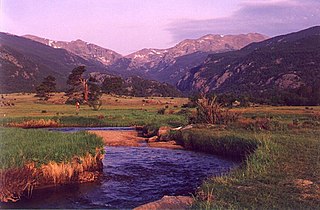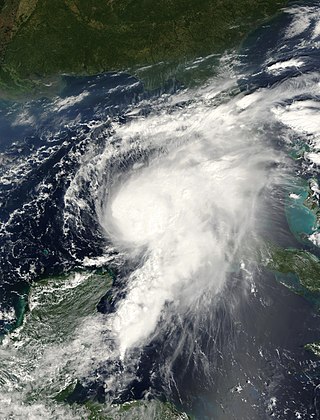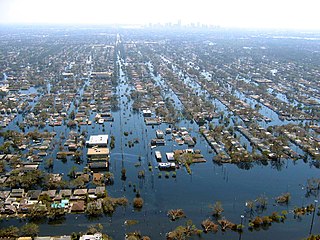
The Big Thompson River is a tributary of the South Platte River, approximately 78 miles (126 km) long, in the U.S. state of Colorado. Originating in Forest Canyon in Rocky Mountain National Park, the river flows into Lake Estes in the town of Estes Park and then through Big Thompson Canyon. It includes four crossings/bridges which are listed on the U.S. National Register of Historic Places.

Hurricane Gordon caused minor damage in the Eastern United States. The seventh named storm and fourth hurricane of the 2000 Atlantic hurricane season, Gordon developed in the extreme western Caribbean Sea from a tropical wave on September 14. Shortly thereafter, the depression moved inland over the Yucatán Peninsula and later emerged into the Gulf of Mexico on September 15. The depression began to quickly organize, and by early on September 16, it was upgraded to Tropical Storm Gordon. After becoming a tropical storm, Gordon continued to intensify and was reclassified as a hurricane about 24 hours later; eventually, the storm peaked as an 80 mph (130 km/h) Category 1 hurricane. However, southwesterly upper-level winds caused Gordon to weaken as it approached land, and it was downgraded to a tropical storm by late on September 17. At 0300 UTC on September 18, Gordon made landfall near Cedar Key, Florida as a strong tropical storm. After moving inland, Gordon rapidly weakened and had deteriorated to tropical depression status by nine hours later. Later that day, Gordon merged with a frontal boundary while centered over Georgia.

A flash flood warning is a severe weather warning product of the National Weather Service that is issued by national weather forecasting agencies throughout the world to alert the public that a flash flood is imminent or occurring in the warned area. A flash flood is a sudden, violent flood after a heavy rain, or occasionally after a dam break. Rainfall intensity and duration, topography, soil conditions, and ground cover contribute to flash flooding.
Floods in the United States are generally caused by excessive rainfall, excessive snowmelt, and dam failure. Below is a list of flood events that were of significant impact to the country during the 20th century, from 1900 through 1999, inclusive.

Floods in the United States (2000–present) is a list of flood events which were of significant impact to the country during the 21st century, since 2000. Floods are generally caused by excessive rainfall, excessive snowmelt, storm surge from hurricanes, and dam failure.
The 2007 Midwest flooding was a major flooding event that occurred in the Midwestern United States in the third week of August 2007. While Hurricane Dean was affecting the Yucatán Peninsula and the Gulf of Mexico, and Tropical Storm Erin was affecting Oklahoma and Texas, a persistent storm system hung over the Midwest for several days, causing repeated flash flooding in the US states of Illinois, Indiana, Iowa, Minnesota, Ohio, and Wisconsin. Cool Canadian air clashed with large quantities of warm moist air from the Gulf, producing torrential rains along a stationary front. 5 deaths across the central United States were attributed to the resulting flooding. Seven Minnesota counties, eight Ohio counties, fourteen counties in Wisconsin, and seven counties in Illinois were declared Federal Disaster Areas.

The effects of Hurricane Jeanne in the Mid-Atlantic region of the United States included two fatalities and $530 million in damage. Originating from a tropical wave off the coast of Africa in early September 2004, Hurricane Jeanne tracked through the Leeward Islands and Hispaniola for several days, resulting in extensive damage and an immense loss of life. After completing a clockwise loop between September 22 and 24, the storm intensified into a major hurricane before striking the Bahamas and Florida. Substantially weaker, the system turned northeastward over Georgia before affecting Delaware, District of Columbia, Maryland, New Jersey, New York, Pennsylvania, Virginia, and West Virginia; all of those states are in the Mid-Atlantic region of the United States. By the evening of September 26, the Hydrometeorological Prediction Center took over responsibility of monitoring the former hurricane over Virginia.

The 2010 Tennessee floods were floods in Middle Tennessee, West Tennessee, south-central and western Kentucky and northern Mississippi areas of the United States of America as the result of torrential rains on May 1 and 2, 2010. Floods from these rains affected the area for several days afterwards, resulting in a number of deaths and widespread property damage.

September 2010 flash flooding in Minnesota and Wisconsin put towns underwater and forced evacuations in southern Minnesota and central Wisconsin. A strong system caused the heavy rain and flash flooding in the Upper Midwest.

Tropical Storm Lee was the thirteenth named storm and fifteenth system overall of the 2011 Atlantic hurricane season, developing from a broad tropical disturbance over the gulf on September 1. It was designated as Tropical Storm Lee the next day. Prior to 2020, when Marco formed on August 22, Lee was tied with 2005's Maria as the earliest-forming 13th Atlantic tropical storm. The system was rather large, and due to drifting, Lee brought flash flooding to the Gulf Coast. Flooding associated with the rains caused significant property damage in the areas, with drowning deaths reported in both Mississippi and Georgia. Elsewhere, the storm helped spread wildfires that destroyed homes and killed two people in Texas, and a traffic accident in Alabama resulted in one death. Rough surf offshore drowned one person in each of these states. After becoming extratropical, Lee caused historic flooding in Pennsylvania, New York, and Canada, mainly Quebec and Ontario.

The High Park fire was a wildfire in the mountains west of Fort Collins in Larimer County, Colorado, United States. It was caused by a lightning strike and was first detected on the morning of June 9, 2012. It was declared 100 percent contained on June 30, 2012, and all associated evacuation orders were lifted. Disambiguation. In 2022 there was another fire called "High Park Fire." That fire started on 05/12/2022 6 miles west of Cripple Creek Colorado. The size at 89% containment was 1,572 acres. Since wildland fire names are typically assigned by personnel on the fire and often based on local knowledge, it is not unusual to have more than one fire with the same name.

The Waldo Canyon fire was a forest fire that started approximately 4 miles (6.4 km) northwest of Colorado Springs, Colorado on June 23, 2012, and was declared 100 percent contained on July 10, 2012, after no smoke plumes were visible on a small portion of the containment line on Blodgett Peak. The fire was active in the Pike National Forest and adjoining areas, covering a total of 18,247 acres. The fire had caused the evacuation of over 32,000 residents of Colorado Springs, Manitou Springs and Woodland Park, several small mountain communities along the southwestern side of U.S. Highway 24, and partial evacuation of the United States Air Force Academy. There were 346 homes destroyed by the fire. U.S. Highway 24, a major east–west road, was closed in both directions. The Waldo Canyon Fire resulted in insurance claims totaling more than US $453.7 million. It was the most destructive fire in Colorado state history, as measured by the number of homes destroyed, until the Black Forest Fire surpassed it almost a year later when it consumed 486 homes and damaged 28 others.

The bill H.R. 3174, long title "To authorize the Secretary of Transportation to obligate funds for emergency relief projects arising from damage caused by severe weather events in 2013, and for other purposes," is a bill that was introduced in the United States House of Representatives during the 113th United States Congress. The bill would allow the United States Department of Transportation to "exceed a $100 million cap on grants to repair roads damaged by a national emergency." The bill was written in response to the 2013 Colorado floods, which caused as much as $500 million worth of damage to Colorado's roads.

Hurricane Linda was a strong tropical cyclone in September 2015 that resulted in heavy rains across portions of Mexico and the Southwestern United States. The seventeenth named storm, eleventh hurricane, and eighth major hurricane of the season, Linda developed southwest of Mexico from a low-pressure area on September 5. Under warm sea surface temperatures and low to moderate wind shear, the system intensified into Tropical Storm Linda by September 6 and a hurricane by the next day. A well-defined eye soon formed within the storm's central dense overcast and Linda reached its peak intensity as a 125 mph (205 km/h) Category 3 major hurricane on the Saffir–Simpson hurricane wind scale on September 8. Thereafter, the storm moved into a stable environment and an area of lower sea surface temperatures, causing rapid weakening. Convective activity dissipated and Linda degenerated into a remnant low on September 10. The lingering system persisted southwest of Baja California, ultimately opening up into a trough on September 14.

The April 2016 North American storm complex was a major storm system that resulted from an upper-level low in the United States stalling and producing record-breaking rain in and around Houston, Texas, resulting in severe flooding, as well as a major snowstorm in the Rocky Mountains. There were more than 17 inches of rain in one day in parts of the city, and up to 4 inches of rain per hour that morning at George Bush Intercontinental Airport. It is described as the wettest April in the city on record.

Tropical Depression Eight caused severe flooding in southeastern Texas in late August 1981. The twelfth tropical cyclone of the annual hurricane season, the depression developed from a tropical disturbance over the Bay of Campeche on August 26. Moving northwestward, the cyclone failed to intensify into a tropical storm before making landfall in the Mexican state of Tamaulipas to the north of Tampico on August 28, with winds of 35 mph (55 km/h). After moving inland, the depression curved north-northwestward before degenerating into a surface low pressure area near the Mexico–United States border on August 29. The remnants moved eastward across Texas and entered Louisiana before dissipating on September 1.

Hurricane Olivia was a powerful and destructive Category 4 hurricane, that brought damaging floods to California and Utah during September 1982. Olivia was the twenty-fourth tropical cyclone, eighteenth named storm, ninth hurricane, and fourth major hurricane of the active 1982 Pacific hurricane season. The storm was first noted as a tropical depression from a ship report off the southern coast of Mexico. Olivia then steadily intensified before becoming a Category 4 hurricane, and reaching its peak intensity with 1-minute sustained winds of around 145 mph (230 km/h), at 18:00 UTC on September 21. The hurricane then rapidly weakened as it passed west of mainland Mexico, before being last noted to the west of California on September 25, as a surface trough.

Beginning on July 24, 2022, and lasting for a week, many flash flooding events hit several areas of the United States. These areas included parts of Missouri and Illinois, especially Greater St. Louis, Eastern Kentucky, Southwest Virginia, parts of West Virginia, and the Las Vegas Valley. Several rounds of severe thunderstorms began in Missouri on July 24, culminating during July 25 and 26, when St. Louis broke its previous 1915 record for the most rainfall in a span of 24 hours. Governor Mike Parson declared a state of emergency on July 26. Over one hundred people were rescued from floods, and two people were killed. Late on July 27 and into July 28, historic flooding began in central Appalachia, particularly in Kentucky, where a state of emergency was declared. A total of 38 people were killed in Kentucky as a direct result of flooding, with a 39th fatality occurring days later during cleanup efforts and a 40th coming in September during cleanup efforts in Pike County.
A severe flood occurred throughout the Las Vegas Valley on July 8, 1999, during the local monsoon season. The storm brought three inches of rainfall to the area, which usually sees only four inches annually. The flood resulted in two deaths, and left some motorists stranded. Police and firefighters conducted 163 rescues throughout the Las Vegas Valley. Flood waters damaged 353 homes and caused $20.5 million in public property damage. It was the most destructive flood in Las Vegas history. A flood control network, developed by the Clark County Regional Flood Control District, was 20-percent finished at the time, helping to mitigate the severity of the flood.



















